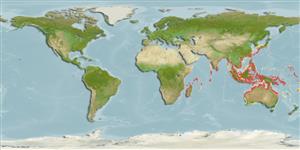Malacostraca |
Decapoda |
Palaemonidae
Environment: milieu / climate zone / depth range / distribution range
Ecology
Benthic; freshwater; brackish; depth range 0 - 30 m (Ref. 104052). Tropical
Indo-West Pacific. Introduced in Nigeria.
Length at first maturity / Size / Weight / Age
Maturity: Lm ? range ? - ? cm Max length : 9.8 cm TL male/unsexed; (Ref. 104052)
It is marketed fresh or dried (Ref. 104052). Subtidal (Ref. 106854). Occurs in low parts of streams, river mouths, estuaries and brackish waters of high salinity, and is rarely found in pure freshwater but often in sea water to a depth of 30 meters. It reproduces in brackish and sea water (Ref. 104052). Also found in creeks/inlets of mangrove swamps (Ref. 121478).
Life cycle and mating behavior
Maturity | Reproduction | Spawning | Eggs | Fecundity | Larvae
Members of the order Decapoda are mostly gonochoric. Mating behavior: Precopulatory courtship ritual is common (through olfactory and tactile cues); usually indirect sperm transfer.
del Mundo, C.M. 2000. (Ref. 10)
IUCN Red List Status (Ref. 130435)
CITES status (Ref. 108899)
Not Evaluated
Not Evaluated
Threat to humans
Human uses
Fisheries: commercial
| FishSource |
Tools
More information
Age/SizeGrowthLength-weightLength-lengthMorphologyLarvaeAbundance
Internet sources
Estimates based on models
Preferred temperature
(Ref.
115969): 25.2 - 29.3, mean 28.7 (based on 1755 cells).
